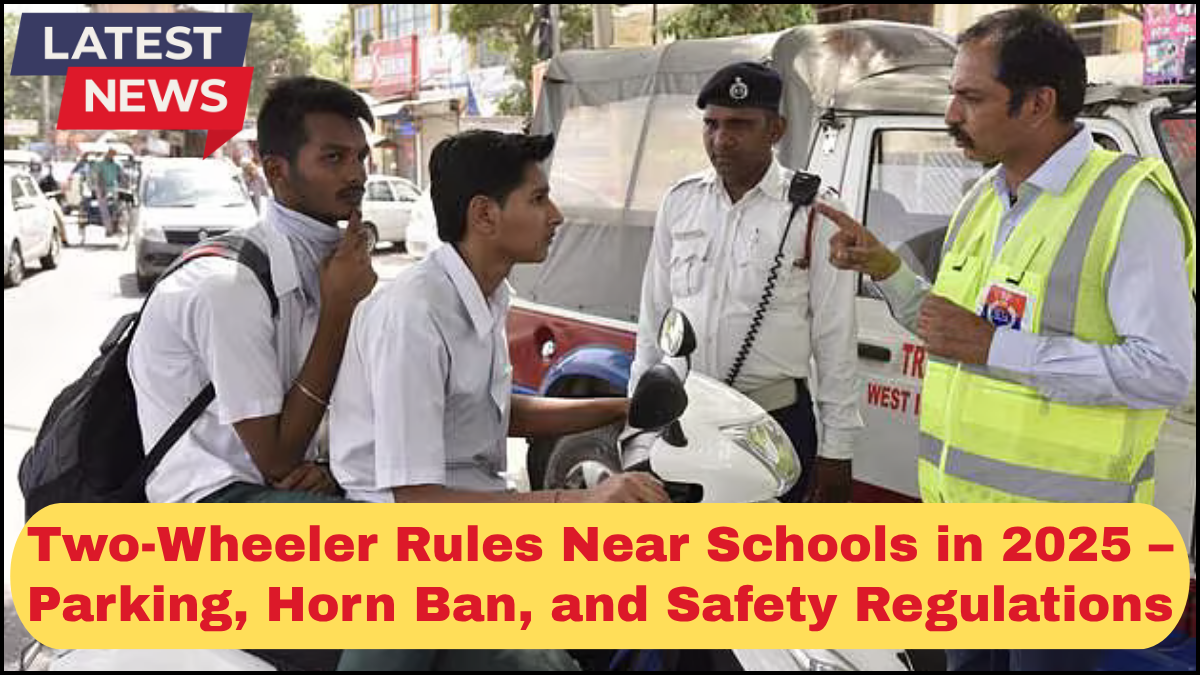As urban areas continue to grow denser and school zones become increasingly congested, the two-wheeler rules near schools in 2025 have been updated across several regions to protect student safety and maintain traffic discipline. With a sharp rise in two-wheeler usage, especially in metro cities, these revised regulations aim to curb reckless driving, minimize noise pollution, and prevent accidents in sensitive school environments.

Let’s break down the core components of these regulations: parking restrictions, horn bans, and safety mandates.
Parking Regulations Around School Zones
One of the most critical changes in the new two-wheeler rules near schools relates to parking violations. In 2025, stricter enforcement has been rolled out to ensure that footpaths, school gates, and entry/exit routes remain clear at all times.
Key Parking Rules:
-
Designated Zones Only: Two-wheelers can only be parked in clearly marked areas at a minimum distance of 50 meters from any school gate.
-
No Parking on Sidewalks: Blocking walkways or bus stops now attracts immediate fines, as it impedes student movement and emergency access.
-
Smart Parking Sensors: Many urban local bodies have integrated smart sensors to detect unauthorized parking & noise violations, enabling real-time monitoring and automated penalties.
-
Time Restrictions: During school start and end hours, temporary no-parking zones are enforced to avoid congestion.
Example: In cities like Bengaluru and Pune, geo-fencing technology has been employed to issue alerts when a vehicle enters a restricted school-zone parking area.
Horn Ban and Noise Control Measures
To protect children from auditory stress and create a calmer environment for learning, a complete horn ban near schools is now a nationwide standard. Honking is no longer just frowned upon—it’s an offense punishable by fines and, in some cases, penalty points on the driver’s license.
What the Horn Ban Includes:
-
Silent Zones: All areas within 100 meters of a school boundary wall are officially classified as “Silent Zones.” Any use of horns here, including reverse horns or modified exhausts, is prohibited.
-
Noise Violation Sensors: Advanced noise sensors are being installed to detect parking & noise violations in school corridors and report them to traffic authorities.
-
School Zone Signage: Large, reflective boards are mandated for all schools, indicating the no-horn policy with QR codes for citizens to report violations directly.
Example: Delhi’s traffic police have begun pilot programs where citizens can report honking incidents through a mobile app, increasing accountability.
Safety Regulations for Two-Wheeler Riders
Beyond parking and noise, two-wheeler rules near schools in 2025 focus heavily on rider safety, especially since many parents drop children off on bikes and scooters.
Updated Safety Requirements:
-
Mandatory Helmet Use: Both rider and pillion must wear ISI-marked helmets, regardless of the distance traveled or the speed of the vehicle.
-
Speed Limit Enforcement: School zones now have a maximum speed cap of 20 km/h for all vehicles, with cameras monitoring and flagging speeders automatically.
-
Child Safety Gear: If a child is riding pillion, safety harnesses or child seats are required. Failure to comply can lead to a fine or temporary suspension of the license.
-
License Checks: Traffic patrol units conduct surprise inspections to ensure riders near schools possess valid licenses and vehicle documents.
Example: In Hyderabad, authorities have implemented “School Safety Patrols” comprising trained volunteers who guide traffic and report infractions in real time.
Enforcement and Penalties
To ensure compliance, municipal authorities and traffic police have increased their presence during school hours. Infringements such as illegal parking, honking, or unsafe riding are now met with:
-
Spot Fines ranging from ₹1,000 to ₹5,000
-
Towing of Unauthorized Two-Wheelers
-
License Points & Blacklisting for Repeat Offenders
-
Public Disclosure of violators via civic apps
Many cities have also integrated CCTV surveillance to assist in issuing e-challans for non-compliance, especially in densely populated areas.
How Schools and Communities Are Supporting the Rules
Educational institutions are also playing a proactive role:
-
Conducting student awareness campaigns on traffic safety.
-
Organizing parent workshops on two-wheeler regulations.
-
Appointing traffic volunteers to assist during school hours.
Communities are pushing for pedestrian-friendly roads, speed bumps, and better signage to ensure a safer commute for children.
FAQs on Two-Wheeler Rules Near Schools
Q1: Is honking completely banned near all schools in India in 2025?
Yes, honking is banned within a 100-meter radius of all recognized schools, and violators face fines under updated traffic laws.
Q2: Can I park my two-wheeler in front of a school for a few minutes?
No, even short-term parking in undesignated areas near schools is prohibited, especially during start and end times.
Q3: Are children allowed to ride as pillion passengers without safety gear?
No. Child safety gear such as harnesses or approved child seats are mandatory for school zones.
Q4: What happens if I break two-wheeler rules near schools repeatedly?
Repeat offenses can lead to higher fines, license suspension, or even legal action, depending on the severity.
Q5: Are these rules applicable only in big cities?
No. These rules are being standardized nationwide, although implementation speed may vary across regions.
click here to learn more